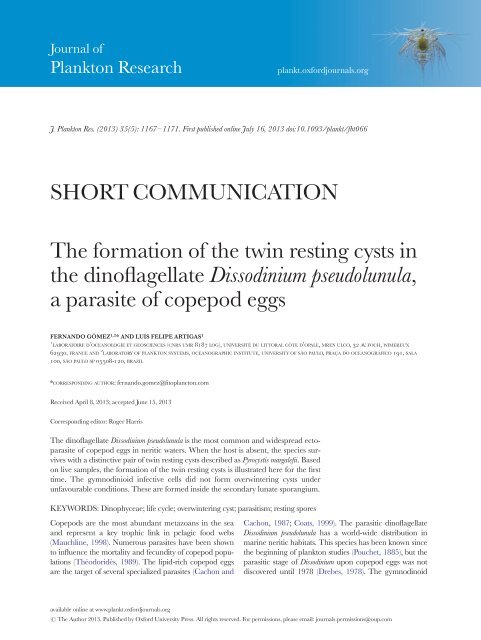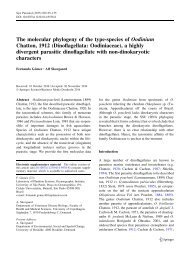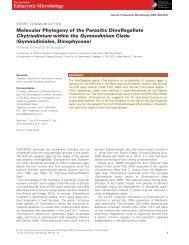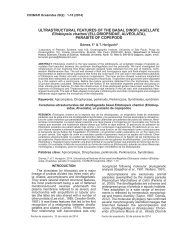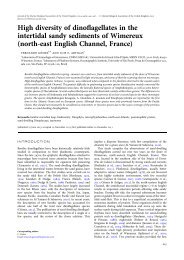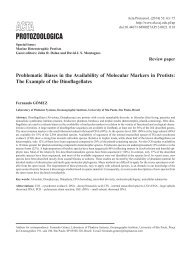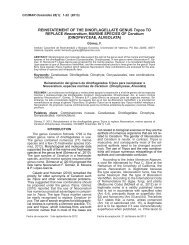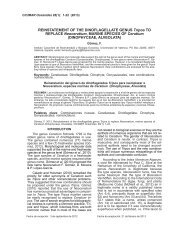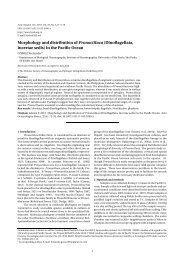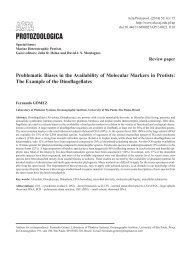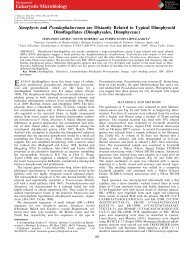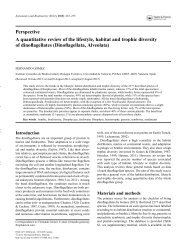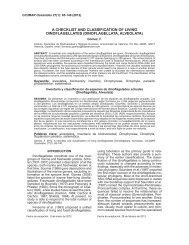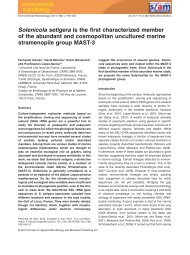The formation of the twin resting cysts in the dinoflagellate Dissodinium pseudolunula, a parasite of copepod eggs
The dinoflagellate Dissodinium pseudolunula is the most common and widespread ectoparasite of copepod eggs in neritic waters. When the host is absent, the species survives with a distinctive pair of twin resting cysts described as Pyrocystis margalefii. Based on live samples, the formation of the twin resting cysts is illustrated here for the first time. The gymnodinioid infective cells did not form overwintering cysts under unfavourable conditions. These are formed inside the secondary lunate sporangium
The dinoflagellate Dissodinium pseudolunula is the most common and widespread ectoparasite
of copepod eggs in neritic waters. When the host is absent, the species survives
with a distinctive pair of twin resting cysts described as Pyrocystis margalefii. Based
on live samples, the formation of the twin resting cysts is illustrated here for the first
time. The gymnodinioid infective cells did not form overwintering cysts under
unfavourable conditions. These are formed inside the secondary lunate sporangium
Create successful ePaper yourself
Turn your PDF publications into a flip-book with our unique Google optimized e-Paper software.
Journal <strong>of</strong><br />
Plankton Research<br />
plankt.oxfordjournals.org<br />
J. Plankton Res. (2013) 35(5): 1167–1171. First published onl<strong>in</strong>e July 16, 2013 doi:10.1093/plankt/fbt066<br />
SHORT COMMUNICATION<br />
<strong>The</strong> <strong>formation</strong> <strong>of</strong> <strong>the</strong> <strong>tw<strong>in</strong></strong> <strong>rest<strong>in</strong>g</strong> <strong>cysts</strong> <strong>in</strong><br />
<strong>the</strong> d<strong>in</strong><strong>of</strong>lagellate Dissod<strong>in</strong>ium <strong>pseudolunula</strong>,<br />
a <strong>parasite</strong> <strong>of</strong> <strong>copepod</strong> <strong>eggs</strong><br />
FERNANDO GÓMEZ 1,2 * AND LUIS FELIPE ARTIGAS 1<br />
1 LABORATOIRE D’OCEANOLOGIE ET GEOSCIENCES (CNRS UMR 8187 LOG), UNIVERSITÉ DU LITTORAL CÔTE D’OPALE, MREN ULCO, 32 AV. FOCH, WIMEREUX<br />
62930, FRANCE AND 2 LABORATORY OF PLANKTON SYSTEMS, OCEANOGRAPHIC INSTITUTE, UNIVERSITY OF SÃO PAULO, PRAÇA DO OCEANOGRÁFICO 191, SALA<br />
100, SÃO PAULOSP05508-120, BRAZIL<br />
*CORRESPONDING AUTHOR: fernando.gomez@fitoplancton.com<br />
Received April 8, 2013; accepted June 15, 2013<br />
Correspond<strong>in</strong>g editor: Roger Harris<br />
<strong>The</strong> d<strong>in</strong><strong>of</strong>lagellate Dissod<strong>in</strong>ium <strong>pseudolunula</strong> is <strong>the</strong> most common and widespread ecto<strong>parasite</strong><br />
<strong>of</strong> <strong>copepod</strong> <strong>eggs</strong> <strong>in</strong> neritic waters. When <strong>the</strong> host is absent, <strong>the</strong> species survives<br />
with a dist<strong>in</strong>ctive pair <strong>of</strong> <strong>tw<strong>in</strong></strong> <strong>rest<strong>in</strong>g</strong> <strong>cysts</strong> described as Pyrocystis margalefii. Based<br />
on live samples, <strong>the</strong> <strong>formation</strong> <strong>of</strong> <strong>the</strong> <strong>tw<strong>in</strong></strong> <strong>rest<strong>in</strong>g</strong> <strong>cysts</strong> is illustrated here for <strong>the</strong> first<br />
time. <strong>The</strong> gymnod<strong>in</strong>ioid <strong>in</strong>fective cells did not form overw<strong>in</strong>ter<strong>in</strong>g <strong>cysts</strong> under<br />
unfavourable conditions. <strong>The</strong>se are formed <strong>in</strong>side <strong>the</strong> secondary lunate sporangium.<br />
KEYWORDS: D<strong>in</strong>ophyceae; life cycle; overw<strong>in</strong>ter<strong>in</strong>g cyst; parasitism; <strong>rest<strong>in</strong>g</strong> spores<br />
Copepods are <strong>the</strong> most abundant metazoans <strong>in</strong> <strong>the</strong> sea<br />
and represent a key trophic l<strong>in</strong>k <strong>in</strong> pelagic food webs<br />
(Mauchl<strong>in</strong>e, 1998). Numerous <strong>parasite</strong>s have been shown<br />
to <strong>in</strong>fluence <strong>the</strong> mortality and fecundity <strong>of</strong> <strong>copepod</strong> populations<br />
(Théodoridès, 1989). <strong>The</strong> lipid-rich <strong>copepod</strong> <strong>eggs</strong><br />
are <strong>the</strong> target <strong>of</strong> several specialized <strong>parasite</strong>s (Cachon and<br />
Cachon, 1987; Coats, 1999). <strong>The</strong> parasitic d<strong>in</strong><strong>of</strong>lagellate<br />
Dissod<strong>in</strong>ium <strong>pseudolunula</strong> has a world-wide distribution <strong>in</strong><br />
mar<strong>in</strong>e neritic habitats. This species has been known s<strong>in</strong>ce<br />
<strong>the</strong> beg<strong>in</strong>n<strong>in</strong>g <strong>of</strong> plankton studies (Pouchet, 1885), but <strong>the</strong><br />
parasitic stage <strong>of</strong> Dissod<strong>in</strong>ium upon <strong>copepod</strong> <strong>eggs</strong> was not<br />
discovered until 1978 (Drebes, 1978). <strong>The</strong> gymnod<strong>in</strong>oid<br />
available onl<strong>in</strong>e at www.plankt.oxfordjournals.org<br />
# <strong>The</strong> Author 2013. Published by Oxford University Press. All rights reserved. For permissions, please email: journals.permissions@oup.com
JOURNAL OF PLANKTON RESEARCH j VOLUME 35 j NUMBER 5 j PAGES 1167–1171 j 2013<br />
d<strong>in</strong>ospores <strong>in</strong>fest planktonic crustacean <strong>eggs</strong>, absorb <strong>the</strong><br />
host contents and form two successive sporangia (a globular<br />
primary sporangium followed by eight crescent lunate<br />
secondary sporangia which develop from <strong>the</strong> former) that<br />
produce new <strong>in</strong>fective gymnod<strong>in</strong>ioid d<strong>in</strong>ospores (Drebes,<br />
1978). <strong>The</strong> species survives <strong>the</strong> host-free season as <strong>rest<strong>in</strong>g</strong><br />
<strong>cysts</strong>. Drebes (Drebes, 1981) was able to germ<strong>in</strong>ate a d<strong>in</strong><strong>of</strong>lagellate<br />
<strong>rest<strong>in</strong>g</strong> cyst, known as Pyrocystis margalefii, <strong>in</strong><br />
culture and he observed that <strong>the</strong> gymnod<strong>in</strong>ioid d<strong>in</strong>ospores<br />
were identical to those <strong>of</strong> Dissod<strong>in</strong>ium <strong>pseudolunula</strong>. However,<br />
he was unable to verify whe<strong>the</strong>r <strong>the</strong> d<strong>in</strong>ospores were able<br />
to <strong>in</strong>fect <strong>copepod</strong> <strong>eggs</strong>. <strong>The</strong>se dist<strong>in</strong>ctive pairs <strong>of</strong> <strong>tw<strong>in</strong></strong><br />
<strong>rest<strong>in</strong>g</strong> <strong>cysts</strong> are widely distributed <strong>in</strong> <strong>the</strong> plankton <strong>of</strong><br />
<strong>the</strong> eastern North Atlantic and North Sea with a peak<br />
<strong>in</strong> numbers <strong>in</strong> August and September (John and Reid,<br />
1983). Molecular phylogeny has revealed that Dissod<strong>in</strong>ium<br />
and Chytriod<strong>in</strong>ium, both ecto<strong>parasite</strong>s <strong>of</strong> crustacean <strong>eggs</strong>,<br />
are close relatives with<strong>in</strong> <strong>the</strong> group <strong>of</strong> Gymnod<strong>in</strong>ium sensu<br />
stricto (Gómez et al., 2009).<br />
Drebes (Drebes, 1981) demonstrated that <strong>the</strong> <strong>in</strong>fective<br />
d<strong>in</strong>ospores that emerged from <strong>the</strong> <strong>tw<strong>in</strong></strong> <strong>rest<strong>in</strong>g</strong> cyst resemble<br />
those <strong>of</strong> Dissod<strong>in</strong>ium <strong>pseudolunula</strong>. However, <strong>the</strong> stage <strong>of</strong><br />
Fig. 1. Light micrographs <strong>of</strong> life stages <strong>of</strong> live specimens <strong>of</strong> Dissod<strong>in</strong>ium <strong>pseudolunula</strong> collected <strong>in</strong> <strong>the</strong> coastal NE English Channel <strong>in</strong> 2010 and 2011.<br />
(A–E) Infected <strong>copepod</strong> <strong>eggs</strong>. (F–Q) Developmental stages <strong>of</strong> <strong>the</strong> globular primary sporangia. (R–AE) Developmental stages <strong>of</strong> <strong>the</strong> lunate<br />
secondary sporangia. (AE–AH) Infective d<strong>in</strong>ospore enclosed <strong>in</strong> an outer hyal<strong>in</strong>e membrane. fl, flagellum. Scale bar: 10 mm. See onl<strong>in</strong>e<br />
supplementary data for a colour version <strong>of</strong> this figure.<br />
1168
F. GÓMEZ AND L. F. ARTIGAS j LIFE CYCLE OF DISSODINIUM, PARASITE OF COPEPOD EGGS<br />
<strong>the</strong> life cycle <strong>of</strong> Dissod<strong>in</strong>ium <strong>in</strong> which <strong>the</strong> <strong>rest<strong>in</strong>g</strong> <strong>cysts</strong> are<br />
formed rema<strong>in</strong>s unknown. This fact also represents a<br />
way to confirm <strong>the</strong> relationship between <strong>the</strong> <strong>tw<strong>in</strong></strong> <strong>rest<strong>in</strong>g</strong><br />
cyst and Dissod<strong>in</strong>ium. <strong>The</strong> most <strong>in</strong>tuitive explanation is<br />
that <strong>the</strong> <strong>in</strong>fective d<strong>in</strong>ospore forms a <strong>rest<strong>in</strong>g</strong> cyst under unfavourable<br />
conditions (when it is unable to f<strong>in</strong>d <strong>the</strong> host).<br />
In fact, <strong>the</strong> <strong>in</strong>fective d<strong>in</strong>ospore forms an outer membrane<br />
(Drebes, 1981). However, this corresponds to a temporary<br />
cyst which differs from <strong>the</strong> <strong>tw<strong>in</strong></strong> <strong>rest<strong>in</strong>g</strong> <strong>cysts</strong> <strong>of</strong><br />
Dissod<strong>in</strong>ium <strong>in</strong> size, shape and cell content. <strong>The</strong> present<br />
study identifies <strong>the</strong> miss<strong>in</strong>g l<strong>in</strong>k between <strong>the</strong> known life<br />
stages <strong>of</strong> Dissod<strong>in</strong>ium and its overw<strong>in</strong>ter<strong>in</strong>g <strong>rest<strong>in</strong>g</strong> cyst.<br />
Live phytoplankton samples were collected weekly<br />
with a 20 mm mesh net <strong>in</strong> 2010 and 2011 <strong>in</strong> coastal waters<br />
<strong>of</strong> <strong>the</strong> NE English Channel (<strong>of</strong>f Wimereux, France), which<br />
are characterized by recurrent blooms <strong>of</strong> diatoms and <strong>the</strong><br />
haptophyte Phaeocystis globosa. Daily sampl<strong>in</strong>g was also<br />
performed <strong>in</strong> a large pool (≏50 m diameter, ≏1 m<br />
depth) that formed dur<strong>in</strong>g low tide along <strong>the</strong> shore at<br />
Wimereux. In addition, <strong>in</strong>tertidal surface sediments at<br />
Wimereux were exam<strong>in</strong>ed follow<strong>in</strong>g <strong>the</strong> sampl<strong>in</strong>g procedure<br />
described by Gómez et al. (Gómez et al., 2011).<br />
Plankton and benthos live samples were settled <strong>in</strong><br />
Utermöhl chambers and exam<strong>in</strong>ed with an <strong>in</strong>verted<br />
microscope (Nikon Eclipse TE2000-S) equipped with a<br />
Nikon Digital Sight DS-2M camera.<br />
Infected <strong>eggs</strong> and globular and lunate sporangia <strong>of</strong><br />
D. <strong>pseudolunula</strong> were common <strong>in</strong> live samples from April<br />
to September, with more specimens <strong>in</strong> June (Fig. 1).<br />
<strong>The</strong> fast-swimm<strong>in</strong>g gymnod<strong>in</strong>ioid d<strong>in</strong>ospores were difficult<br />
to record, and <strong>the</strong> micrographs were taken when<br />
<strong>the</strong>y were enclosed <strong>in</strong>side a th<strong>in</strong> hyal<strong>in</strong>e outer membrane<br />
(Fig. 1AE–AG). Only 10 pairs <strong>of</strong> <strong>tw<strong>in</strong></strong> <strong>rest<strong>in</strong>g</strong> <strong>cysts</strong> were<br />
observed between July and September <strong>in</strong> 2010 and 2011<br />
Fig. 2. Light micrographs <strong>of</strong> <strong>the</strong> lunate sporangium and <strong>the</strong> <strong>rest<strong>in</strong>g</strong> cyst <strong>of</strong> live specimens <strong>of</strong> Dissod<strong>in</strong>ium <strong>pseudolunula</strong> collected <strong>in</strong> <strong>the</strong> coastal NE<br />
English Channel <strong>in</strong> 2010 and 2011. (A–E) Lunate secondary sporangia. (F–J) Formation <strong>of</strong> a pair <strong>of</strong> <strong>tw<strong>in</strong></strong> <strong>rest<strong>in</strong>g</strong> <strong>cysts</strong> <strong>in</strong>side a lunate sporangium.<br />
(K–N) Pairs <strong>of</strong> <strong>tw<strong>in</strong></strong> <strong>rest<strong>in</strong>g</strong> <strong>cysts</strong>. (O–R) S<strong>in</strong>gle <strong>rest<strong>in</strong>g</strong> cyst. (S–T) Pairs <strong>of</strong> cells with <strong>the</strong> appearance <strong>of</strong> <strong>the</strong> <strong>rest<strong>in</strong>g</strong> cyst. Scale bar: 10 mm<br />
1169
JOURNAL OF PLANKTON RESEARCH j VOLUME 35 j NUMBER 5 j PAGES 1167–1171 j 2013<br />
(Fig. 2K–R). In sand samples, a s<strong>in</strong>gle <strong>rest<strong>in</strong>g</strong> cyst was<br />
also found on 17 September 2010 (Fig. 2R).<br />
Several lunate sporangia and <strong>tw<strong>in</strong></strong> <strong>rest<strong>in</strong>g</strong> <strong>cysts</strong> were<br />
observed on 8 July 2010. As a general trend, each recently<br />
released lunate sporangium conta<strong>in</strong>ed a hyal<strong>in</strong>e mass<br />
and a prom<strong>in</strong>ent nucleus. This content transformed by<br />
b<strong>in</strong>ary fission <strong>in</strong>to eight gymnod<strong>in</strong>ioid cells that acquired<br />
a green-brownish pigmentation (Fig. 1, see Supplementary<br />
data, Video, http://www.youtube.com/watch?v=Y-<br />
GA6U3EhdU). However, some lunate sporangia showed<br />
an <strong>in</strong>tense pigmentation before <strong>the</strong> <strong>formation</strong> <strong>of</strong> <strong>the</strong> first<br />
pair <strong>of</strong> daughter cells (Fig. 2E). One <strong>of</strong> <strong>the</strong>se lunate sporangia<br />
conta<strong>in</strong>ed a pair <strong>of</strong> <strong>the</strong> <strong>tw<strong>in</strong></strong> <strong>rest<strong>in</strong>g</strong> <strong>cysts</strong>. <strong>The</strong>y lacked<br />
<strong>the</strong> dist<strong>in</strong>ctive orange granules that characterized <strong>the</strong><br />
typical <strong>tw<strong>in</strong></strong> <strong>rest<strong>in</strong>g</strong> <strong>cysts</strong> (Fig. 2F–J). This is <strong>the</strong> first direct<br />
evidence that <strong>the</strong> <strong>tw<strong>in</strong></strong> <strong>rest<strong>in</strong>g</strong> <strong>cysts</strong> are formed <strong>in</strong>side a<br />
lunate secondary sporangium <strong>of</strong> Dissod<strong>in</strong>ium. In addition, a<br />
pair <strong>of</strong> cells <strong>in</strong>side an outer hyal<strong>in</strong>e membrane was<br />
observed <strong>in</strong> a sand sample collected on 17 May 2010<br />
(Fig. 2S–T). <strong>The</strong> gra<strong>in</strong>y appearance <strong>of</strong> <strong>the</strong> cell contents<br />
and <strong>the</strong> presence <strong>of</strong> an orange granule strongly resembled<br />
a cell that germ<strong>in</strong>ated from a <strong>tw<strong>in</strong></strong> <strong>rest<strong>in</strong>g</strong> cyst.<br />
Based on cultures, Drebes (Drebes, 1978) observed<br />
that <strong>the</strong> <strong>in</strong>fective d<strong>in</strong>ospores formed an outer hyal<strong>in</strong>e<br />
membrane, and <strong>the</strong>y eventually divided <strong>in</strong>side. This has<br />
been also observed <strong>in</strong> natural samples (Fig. 1AH). In<br />
<strong>parasite</strong>s, as a general trend, it is considered that <strong>the</strong> <strong>in</strong>fective<br />
d<strong>in</strong>ospores form <strong>the</strong> <strong>rest<strong>in</strong>g</strong> <strong>cysts</strong> when <strong>the</strong>y are<br />
unable to f<strong>in</strong>d a host (Drebes, 1984). However, <strong>the</strong> <strong>tw<strong>in</strong></strong><br />
<strong>rest<strong>in</strong>g</strong> <strong>cysts</strong> <strong>of</strong> D. <strong>pseudolunula</strong> differed from <strong>the</strong> <strong>in</strong>fective<br />
d<strong>in</strong>ospore <strong>in</strong> size, shape and cell content. It is difficult to<br />
accept that <strong>the</strong> latter should be able to form <strong>tw<strong>in</strong></strong> <strong>rest<strong>in</strong>g</strong><br />
<strong>cysts</strong> with a biomass five to eight times greater than <strong>the</strong> <strong>in</strong>fective<br />
d<strong>in</strong>ospore itself. In addition, <strong>the</strong> exhausted <strong>in</strong>fective<br />
d<strong>in</strong>ospore has to accumulate <strong>the</strong> energetic reserves to<br />
survive <strong>the</strong> autumn–w<strong>in</strong>ter period, and to form <strong>the</strong> cellular<br />
functions <strong>of</strong> a new <strong>in</strong>fective d<strong>in</strong>ospore for <strong>the</strong> next spr<strong>in</strong>g.<br />
Drebes (Drebes, 1981) hypo<strong>the</strong>sized that <strong>the</strong> primary sporangium<br />
develops a certa<strong>in</strong> number <strong>of</strong> <strong>rest<strong>in</strong>g</strong> <strong>cysts</strong> <strong>in</strong>stead <strong>of</strong><br />
secondary lunate sporangia, as a possible reaction to chang<strong>in</strong>g<br />
environmental conditions. This study has revealed that<br />
<strong>the</strong> <strong>tw<strong>in</strong></strong> <strong>rest<strong>in</strong>g</strong> <strong>cysts</strong> are formed <strong>in</strong>side <strong>the</strong> secondary lunate<br />
sporangium (Fig. 2F–J). <strong>The</strong> pair <strong>of</strong> <strong>tw<strong>in</strong></strong> <strong>rest<strong>in</strong>g</strong> <strong>cysts</strong><br />
receives 1/8 <strong>of</strong> <strong>the</strong> lipid reserves <strong>of</strong> <strong>the</strong> <strong>in</strong>fected <strong>copepod</strong><br />
Fig. 3. Life cycle <strong>of</strong> Dissod<strong>in</strong>ium <strong>pseudolunula</strong>.<br />
1170
F. GÓMEZ AND L. F. ARTIGAS j LIFE CYCLE OF DISSODINIUM, PARASITE OF COPEPOD EGGS<br />
egg. A host <strong>in</strong>fection could provide 8 lunate sporangia and<br />
<strong>the</strong> subsequent 8 pairs (16 cells) <strong>of</strong> <strong>rest<strong>in</strong>g</strong> <strong>cysts</strong>. Drebes<br />
(Drebes, 1981) observed that <strong>the</strong> cells that germ<strong>in</strong>ated to<br />
form <strong>the</strong> <strong>tw<strong>in</strong></strong> <strong>rest<strong>in</strong>g</strong> <strong>cysts</strong> were eventually able to divide.<br />
This may be <strong>the</strong> case <strong>in</strong> <strong>the</strong> specimens illustrated <strong>in</strong> Fig. 2S–<br />
T. Consequently, each <strong>in</strong>fected egg may provide 32 new <strong>in</strong>fective<br />
d<strong>in</strong>ospores for <strong>the</strong> follow<strong>in</strong>g spr<strong>in</strong>g (Figs 1 and 2).<br />
Intuitively, one might suggest that <strong>the</strong> factor that triggers<br />
<strong>the</strong> <strong>formation</strong> <strong>of</strong> <strong>the</strong> <strong>tw<strong>in</strong></strong> <strong>rest<strong>in</strong>g</strong> <strong>cysts</strong> is <strong>the</strong> absence <strong>of</strong><br />
<strong>copepod</strong> <strong>eggs</strong>. However, <strong>the</strong> secondary lunate sporangium<br />
may be unable to directly sense <strong>the</strong> presence <strong>of</strong> hosts <strong>in</strong><br />
<strong>the</strong> surround<strong>in</strong>g waters. It is uncerta<strong>in</strong> whe<strong>the</strong>r <strong>the</strong> decrease<br />
<strong>in</strong> <strong>the</strong> size or quality <strong>of</strong> <strong>the</strong> <strong>eggs</strong> <strong>in</strong>duces <strong>the</strong> <strong>formation</strong><br />
<strong>of</strong> <strong>the</strong> <strong>rest<strong>in</strong>g</strong> <strong>cysts</strong> as a mechanism to avoid <strong>the</strong> failure<br />
<strong>of</strong> <strong>the</strong> next generation <strong>of</strong> <strong>in</strong>fective d<strong>in</strong>ospores. Ano<strong>the</strong>r possibilitywouldbethat<strong>the</strong><strong>tw<strong>in</strong></strong><strong>rest<strong>in</strong>g</strong>cystisproducedata<br />
constant rate throughout <strong>the</strong> year, <strong>in</strong> order to provide a permanent<br />
seed<strong>in</strong>g bank. However, <strong>the</strong> active Dissod<strong>in</strong>ium form<br />
is common <strong>in</strong> April and May, while <strong>the</strong> <strong>rest<strong>in</strong>g</strong> <strong>cysts</strong> were<br />
ma<strong>in</strong>ly observed <strong>in</strong> July–September (John and Reid,<br />
1983). <strong>The</strong> <strong>tw<strong>in</strong></strong> <strong>rest<strong>in</strong>g</strong> <strong>cysts</strong> are preferentially formed <strong>in</strong><br />
<strong>the</strong> host-free season.<br />
This study provides new <strong>in</strong>sights <strong>in</strong>to <strong>the</strong> life strategies<br />
<strong>of</strong> this important <strong>parasite</strong> group (Fig. 3). <strong>The</strong> production<br />
<strong>of</strong> <strong>cysts</strong> has been reported <strong>in</strong> <strong>parasite</strong>s <strong>of</strong> t<strong>in</strong>t<strong>in</strong>nid ciliates<br />
(Coats et al., 2010). However, we know little about <strong>the</strong> overw<strong>in</strong>ter<strong>in</strong>g<br />
<strong>cysts</strong> <strong>in</strong> parasitic d<strong>in</strong><strong>of</strong>lagellates. Dissod<strong>in</strong>ium and<br />
o<strong>the</strong>r <strong>parasite</strong>s on <strong>copepod</strong> <strong>eggs</strong> may be a contributory<br />
factor to <strong>the</strong> large year-to-year variability <strong>in</strong> <strong>the</strong> stand<strong>in</strong>g<br />
stock <strong>of</strong> <strong>copepod</strong>s. It is important to understand <strong>the</strong>ir life<br />
cycles as a first step and to <strong>in</strong>clude parasitism <strong>in</strong> <strong>the</strong><br />
models <strong>of</strong> secondary production <strong>in</strong> <strong>the</strong> ocean.<br />
S U P P L E ME N TA RY DATA<br />
Supplementary data can be found onl<strong>in</strong>e at http://plankt.oxfordjournals.org.<br />
ACKNOWLEDGEMENTS<br />
We thank <strong>the</strong> crew <strong>of</strong> <strong>the</strong> R/V Sepia II (INSU) and UMR<br />
LOG technicians and students for <strong>the</strong>ir help <strong>in</strong> <strong>the</strong> field<br />
sampl<strong>in</strong>g <strong>of</strong> <strong>the</strong> Wimereux-Slack transect, which was part<br />
<strong>of</strong> <strong>the</strong> weekly monitor<strong>in</strong>g supported by <strong>the</strong> INTERREG<br />
IVA “2 Seas” DYMAPHY project, co-funded by E.R.D.F.<br />
funds.<br />
FUNDING<br />
F.G. was supported by a UL1 post-doctoral grant and a<br />
CNRS convention <strong>of</strong> research on phytoplankton. F.G. is<br />
currently supported by <strong>the</strong> Brazilian contract BJT 370646/<br />
2013-14 <strong>of</strong> Conselho Nacional de Desenvolvimento<br />
Científico e Tecnológico.<br />
REFERENCES<br />
Cachon, J. and Cachon, M. (1987) Parasitic d<strong>in</strong><strong>of</strong>lagellates. In Taylor,<br />
F. J. R. (ed.), <strong>The</strong> Biology <strong>of</strong> D<strong>in</strong><strong>of</strong>lagellates. Blackwell, Oxford, pp.<br />
571–610.<br />
Coats, D. W. (1999) Parasitic life styles <strong>of</strong> mar<strong>in</strong>e d<strong>in</strong><strong>of</strong>lagellates.<br />
J. Eukaryot. Microbiol., 46, 402–409.<br />
Coats,D.W.,Kim,S.,Bachvar<strong>of</strong>f,T.R.et al. (2010) T<strong>in</strong>t<strong>in</strong>nophagus acutus<br />
n. g., n. sp. (Phylum D<strong>in</strong><strong>of</strong>lagellata), an ecto<strong>parasite</strong> <strong>of</strong> <strong>the</strong> ciliate<br />
T<strong>in</strong>t<strong>in</strong>nopsis cyl<strong>in</strong>drica Daday 1887, and its relationship to Duboscquod<strong>in</strong>ium<br />
coll<strong>in</strong>i Grassé 1952. J. Eukaryot. Microbiol., 57, 468–482.<br />
Drebes, G. (1978) Dissod<strong>in</strong>ium <strong>pseudolunula</strong> (D<strong>in</strong>ophyta), a <strong>parasite</strong> on<br />
<strong>copepod</strong> <strong>eggs</strong>. Br. Phycol. J., 13, 319–327.<br />
Drebes, G. (1981) Possible <strong>rest<strong>in</strong>g</strong> spores <strong>of</strong> Dissod<strong>in</strong>ium <strong>pseudolunula</strong><br />
(D<strong>in</strong>ophyta) and <strong>the</strong>ir relation to o<strong>the</strong>r taxa. Br. Phycol. J., 16, 207–215.<br />
Drebes, G. (1984) Life cycle and host specificity <strong>of</strong> mar<strong>in</strong>e parasitic<br />
d<strong>in</strong>ophytes. Helgoländer Meeresunters., 37, 603–622.<br />
Gómez, F., López-García, P. and Moreira, D. (2011) Molecular phylogeny<br />
<strong>of</strong> <strong>the</strong> sand-dwell<strong>in</strong>g d<strong>in</strong><strong>of</strong>lagellates Amphid<strong>in</strong>iopsis hirsuta and A. swedmarkii<br />
(Perid<strong>in</strong>iales, D<strong>in</strong>ophyceae). Acta Protozool., 50, 255–262.<br />
Gómez, F., Moreira, D. and López-García, P. (2009) Life cycle and molecular<br />
phylogeny <strong>of</strong> <strong>the</strong> d<strong>in</strong><strong>of</strong>lagellates Chytriod<strong>in</strong>ium and Dissod<strong>in</strong>ium,<br />
ecto<strong>parasite</strong>s <strong>of</strong> <strong>copepod</strong> <strong>eggs</strong>. Eur. J. Protistol., 45, 260–270.<br />
John, A. W. G. and Reid, P. C. (1983) Possible <strong>rest<strong>in</strong>g</strong> <strong>cysts</strong> <strong>of</strong> Dissod<strong>in</strong>ium<br />
<strong>pseudolunula</strong> Swift ex Elbrächter et Drebes <strong>in</strong> <strong>the</strong> Nor<strong>the</strong>ast Atlantic<br />
and <strong>the</strong> North Sea. Br. Phycol. J., 18, 61–66.<br />
Mauchl<strong>in</strong>e, J. (1998) <strong>The</strong> biology <strong>of</strong> calanoid <strong>copepod</strong>s. Adv. Mar. Biol.,<br />
33, 1–710.<br />
Pouchet, G. (1885) Nouvelle contribution à l’histoire des Périd<strong>in</strong>iens<br />
mar<strong>in</strong>s. J. Anat. Physiol., 21, 28–88.<br />
Théodoridès, J. (1989) Parasitology <strong>of</strong> mar<strong>in</strong>e zooplankton. Adv. Mar.<br />
Biol., 25, 117–177.<br />
1171


